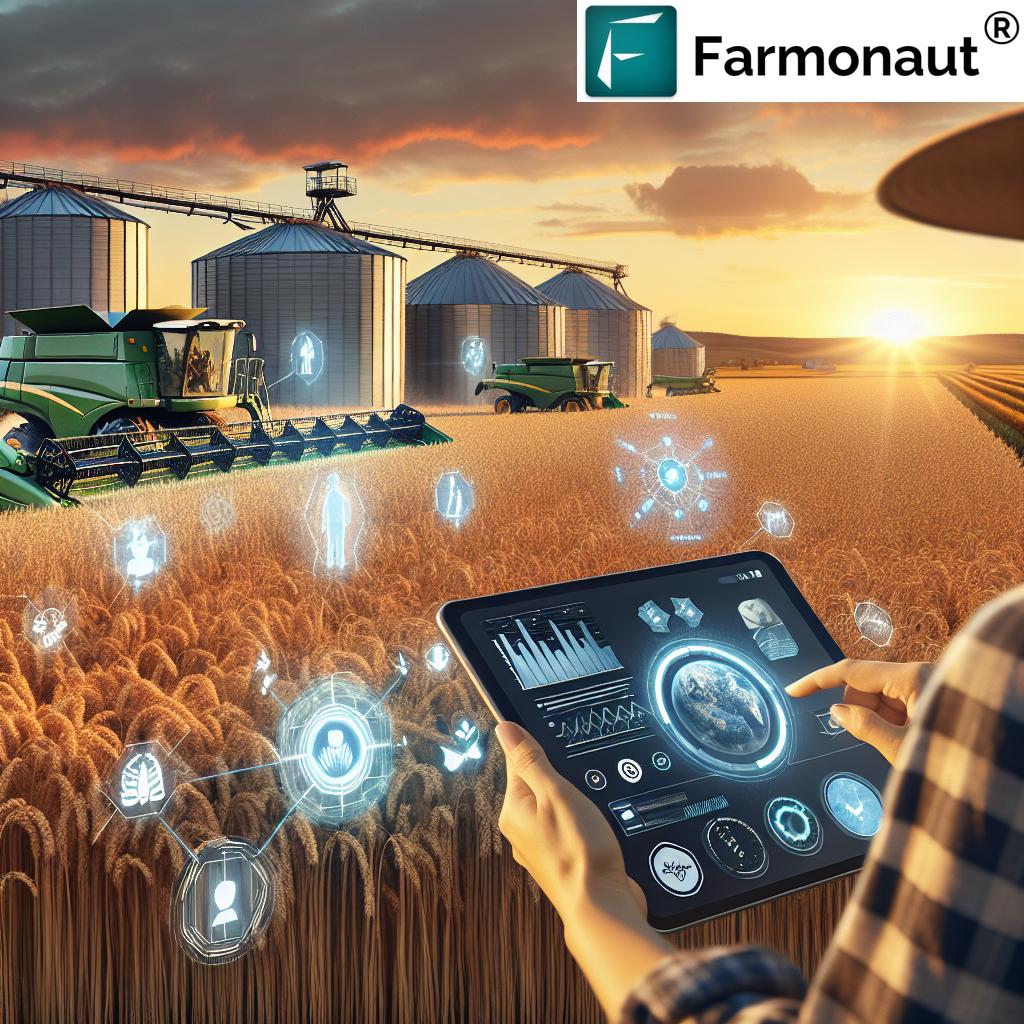Revolutionizing Canadian Prairie Farming: Farmonaut’s 2024 Guide to Precision Agriculture and Crop Yield Optimization

“Canadian prairie farmers adopting precision agriculture techniques can increase crop yields by up to 20% while reducing input costs.”
Welcome to Farmonaut’s comprehensive 2024 guide on revolutionizing Canadian prairie farming through precision agriculture and crop yield optimization. As we step into February 2024, the agricultural landscape is evolving rapidly, and we’re here to keep you informed about the latest trends, innovations, and market insights that are shaping the future of farming in Canada and beyond.
In this extensive blog post, we’ll explore groundbreaking advancements in wheat genetics research, cutting-edge grain storage technology, and the transformative power of precision agriculture. We’ll delve into sustainable farming practices, analyze agricultural market trends, and provide valuable insights into herbicide selection, field management, and agricultural data analysis.
Whether you’re managing vast prairie cash crops or exploring new farming technologies, this guide offers essential knowledge for Canadian farmers and global agriculture professionals alike. Join us as we navigate the exciting future of farming, equipped with Farmonaut’s expert analysis of market dynamics, weather impacts, and innovative solutions driving the industry forward.
The Rise of Precision Agriculture in Canadian Prairies
Precision agriculture technology is revolutionizing the way Canadian prairie farmers approach their operations. By leveraging advanced tools and data-driven insights, farmers can optimize their crop yields, reduce input costs, and minimize environmental impact. Let’s explore some key aspects of this agricultural revolution:
- Satellite-Based Crop Monitoring: Farmonaut’s satellite imagery technology provides real-time insights into crop health, allowing farmers to make informed decisions about irrigation, fertilization, and pest management.
- AI-Powered Advisory Systems: Our Jeevn AI system delivers personalized recommendations based on real-time data, helping farmers optimize their farming strategies.
- Drone Technology: Unmanned aerial vehicles (UAVs) are increasingly used for precise field mapping, crop scouting, and even targeted pesticide application.
- IoT Sensors: Internet of Things (IoT) devices placed throughout fields provide continuous data on soil moisture, temperature, and other critical factors.
By adopting these precision agriculture technologies, Canadian prairie farmers can significantly increase their productivity while reducing resource waste. The integration of these tools into farming operations is not just a trend but a necessary evolution in modern agriculture.
Breakthrough in Wheat Genetics Research
Recent advancements in wheat genetics research are opening new possibilities for Canadian prairie farmers. These breakthroughs are particularly significant given wheat’s status as a staple crop in the region. Here’s what’s on the horizon:
- Drought-Resistant Varieties: Scientists have developed wheat strains that can thrive with less water, a crucial advancement for prairie regions prone to dry spells.
- Enhanced Nutrient Profiles: New wheat varieties boast improved protein content and essential micronutrients, addressing both nutritional needs and market demands.
- Disease Resistance: Genetic modifications have resulted in wheat types more resistant to common prairie crop diseases, reducing the need for chemical interventions.
- Yield Potential: Ongoing research aims to increase the yield potential of wheat, with some new varieties showing promising results in field trials.
These advancements in wheat genetics are not just scientific achievements; they represent real opportunities for Canadian prairie farmers to improve their crop resilience, yield, and market value. As these new varieties become available, farmers should consider integrating them into their crop rotation strategies.
Innovations in Grain Storage Technology
Effective grain storage is crucial for maintaining crop quality and maximizing profits. The latest innovations in this field are helping Canadian prairie farmers reduce post-harvest losses and improve their bottom line. Let’s explore some of these advancements:
- Smart Bin Monitoring: Advanced sensors and IoT devices allow for real-time monitoring of temperature, moisture, and CO2 levels in grain bins, preventing spoilage and maintaining quality.
- Automated Aeration Systems: These systems use weather data and bin conditions to automatically optimize airflow, maintaining ideal storage conditions without constant manual intervention.
- Mobile Apps for Bin Management: Farmers can now monitor and manage their grain storage from anywhere using smartphone apps, providing unprecedented convenience and control.
- Improved Auger Technology: New auger designs reduce grain damage during transfer, preserving quality and reducing waste.
By implementing these innovative grain storage solutions, Canadian prairie farmers can significantly reduce post-harvest losses, maintain higher grain quality, and ultimately increase their profitability. The integration of these technologies aligns perfectly with the broader trend towards precision agriculture and data-driven farming practices.
“Advanced grain storage technology can reduce post-harvest losses by up to 15%, significantly improving farm profitability in Canada.”
Agricultural Market Trends Shaping Canadian Farming
Understanding current agricultural market trends is essential for Canadian prairie farmers to make informed decisions about crop selection, investment, and marketing strategies. Here’s an overview of key trends influencing the market in 2024:
- Canola Demand: Global demand for canola oil continues to rise, driven by its health benefits and use in biofuel production. Canadian farmers are well-positioned to capitalize on this trend.
- Soybean Market Fluctuations: International trade dynamics are impacting soybean prices. Farmers should closely monitor these changes when planning their crop rotations.
- Potato Industry Growth: The processed potato market is expanding, offering opportunities for diversification in prairie farming operations.
- Organic and Specialty Grains: There’s a growing market for organic and specialty grain products, presenting niche opportunities for farmers willing to adapt their practices.
- Carbon Credit Markets: The emerging carbon credit market offers potential additional revenue streams for farmers implementing sustainable practices.
These market trends underscore the importance of flexibility and diversification in modern farming operations. By staying informed and adapting to market demands, Canadian prairie farmers can optimize their crop selection and maximize their profitability.
Explore Farmonaut’s API for real-time agricultural data
Sustainable Farming Practices for Canadian Prairies
Sustainability is no longer just a buzzword; it’s a necessity in modern agriculture. Canadian prairie farmers are increasingly adopting sustainable practices that not only benefit the environment but also improve long-term soil health and farm profitability. Here are some key sustainable farming practices gaining traction:
- Conservation Tillage: Minimizing soil disturbance helps retain moisture, reduce erosion, and improve soil structure.
- Cover Cropping: Planting cover crops between main crop seasons enhances soil health, prevents erosion, and can provide additional income.
- Precision Nutrient Management: Using data-driven approaches to apply fertilizers more efficiently reduces waste and environmental impact.
- Integrated Pest Management (IPM): Combining biological, cultural, and chemical methods for pest control minimizes pesticide use and promotes ecosystem balance.
- Water Conservation Techniques: Implementing efficient irrigation systems and water management practices is crucial in water-scarce prairie regions.
By adopting these sustainable practices, Canadian prairie farmers can improve their soil health, reduce input costs, and potentially access new markets that value sustainably produced crops. Moreover, these practices align well with emerging carbon credit markets, offering additional revenue potential.
Advancements in Farm Equipment and Machinery
The evolution of farm equipment and machinery is playing a crucial role in the modernization of Canadian prairie farming. These advancements are enhancing efficiency, precision, and overall productivity. Let’s explore some of the latest innovations:
- Autonomous Tractors: Self-driving tractors equipped with GPS and obstacle detection systems are becoming a reality, allowing for 24/7 operation and reducing labor costs.
- Precision Planting Equipment: Advanced seeders can adjust seed depth and spacing on-the-go, optimizing planting based on soil conditions and field mapping data.
- Smart Sprayers: These machines use AI and computer vision to identify and target specific weeds, significantly reducing herbicide use.
- Robotic Harvesters: For crops like fruits and vegetables, robotic harvesters are being developed to address labor shortages and increase harvesting efficiency.
- Telematics and Fleet Management: Advanced tracking and diagnostic systems help farmers manage their equipment fleet more efficiently, reducing downtime and maintenance costs.
These technological advancements in farm equipment are not just about convenience; they’re transforming the way Canadian prairie farmers approach their operations. By integrating these smart machines with precision agriculture techniques, farmers can achieve new levels of efficiency and sustainability.
Integrated Farming Solutions for Canadian Prairies
Integrated farming operations are becoming increasingly popular among Canadian prairie farmers, offering a holistic approach to agriculture that combines various elements of farm management. This approach not only optimizes resource use but also creates synergies between different aspects of the farm. Here’s how integrated farming solutions are taking shape:
- Crop-Livestock Integration: Combining crop production with livestock farming can improve soil fertility through manure application and provide additional income streams.
- Agroforestry: Incorporating trees into agricultural landscapes can provide windbreaks, improve soil health, and offer additional products like fruits or timber.
- Integrated Pest Management (IPM): This approach combines biological, cultural, and chemical pest control methods to minimize pesticide use and promote ecological balance.
- Precision Agriculture Integration: Combining various precision agriculture technologies creates a comprehensive farm management system, from planting to harvest.
- Data Integration Platforms: Software solutions that integrate data from various farm operations provide a holistic view of the farm’s performance and guide decision-making.
By adopting integrated farming solutions, Canadian prairie farmers can diversify their operations, reduce risks, and create more resilient and sustainable farming systems. These approaches align well with both economic and environmental goals, positioning farms for long-term success.

The Role of Agricultural Data Management in Modern Farming
In the era of digital agriculture, effective data management has become a cornerstone of successful farming operations. For Canadian prairie farmers, leveraging agricultural data can lead to more informed decision-making and improved farm performance. Here’s how data management is transforming prairie farming:
- Field Mapping and Analysis: High-resolution field maps combined with soil analysis data help in creating precise management zones for variable rate applications.
- Yield Data Interpretation: Analyzing historical yield data helps identify patterns and optimize crop rotations and management practices.
- Weather Data Integration: Incorporating local weather data into farm management systems allows for more accurate planning of field operations and resource allocation.
- Machine Learning Algorithms: Advanced algorithms can predict crop yields, pest outbreaks, and optimal harvest times based on multiple data inputs.
- Blockchain for Traceability: Implementing blockchain technology in data management ensures transparency and traceability in the supply chain, adding value to farm products.
Farmonaut’s platform plays a crucial role in this data-driven approach, offering tools for satellite-based crop monitoring, AI-powered advisory systems, and comprehensive data integration. By leveraging these technologies, Canadian prairie farmers can make more precise decisions, optimize their operations, and ultimately increase their profitability.
Access Farmonaut’s API Developer Docs for integration
Optimizing Herbicide Selection for Prairie Crops
Effective weed management is crucial for maximizing crop yields in Canadian prairie farming. The selection and application of herbicides play a significant role in this process. Here’s how farmers can optimize their herbicide strategies:
- Precision Application: Using GPS-guided sprayers and variable rate technology to apply herbicides only where needed, reducing overall usage and environmental impact.
- Resistance Management: Implementing herbicide rotation and using multiple modes of action to prevent the development of herbicide-resistant weeds.
- Timing Optimization: Utilizing weather data and crop growth stage information to determine the most effective timing for herbicide applications.
- Site-Specific Weed Management: Employing precision agriculture techniques to map weed populations and tailor herbicide applications accordingly.
- Integration with Cover Crops: Using cover crops as part of an integrated weed management strategy to reduce reliance on chemical herbicides.
By adopting these advanced herbicide selection and application strategies, Canadian prairie farmers can effectively manage weeds while minimizing environmental impact and reducing input costs. This approach aligns well with the broader trend towards sustainable and precision agriculture practices.
Weather Impact on Prairie Farming and Adaptation Strategies
The Canadian prairies are known for their variable and sometimes extreme weather conditions, which can significantly impact farming operations. Understanding these impacts and developing adaptation strategies is crucial for long-term success. Here’s how prairie farmers can navigate weather challenges:
- Climate-Smart Crop Selection: Choosing crop varieties that are well-adapted to local climate conditions and have better resilience to weather extremes.
- Improved Weather Forecasting: Utilizing advanced weather prediction tools and integrating this data into farm management systems for better decision-making.
- Water Management Strategies: Implementing effective irrigation and drainage systems to manage both drought and excess moisture situations.
- Soil Conservation Practices: Adopting techniques like no-till farming and cover cropping to improve soil moisture retention and reduce erosion.
- Crop Insurance and Risk Management: Exploring comprehensive crop insurance options and developing risk management strategies to mitigate weather-related losses.
By implementing these strategies and staying informed about weather patterns and climate trends, Canadian prairie farmers can build more resilient farming operations capable of thriving in the face of weather uncertainties.
The Future of Canadian Prairie Farming: Trends and Predictions
As we look towards the future of Canadian prairie farming, several trends and predictions emerge that will shape the industry in the coming years:
- Increased Automation: We expect to see a greater adoption of autonomous machinery and AI-driven farm management systems.
- Vertical Integration: More farmers may engage in value-added processing and direct marketing to increase profitability.
- Diversification of Crops: Climate change may lead to the introduction of new crop varieties suited to changing prairie conditions.
- Emphasis on Soil Health: There will likely be a growing focus on regenerative agriculture practices to improve long-term soil productivity.
- Data-Driven Decision Making: The use of big data and predictive analytics will become increasingly central to farm management.
- Sustainable Energy Integration: We may see more farms incorporating renewable energy sources like solar and wind power into their operations.
These trends point towards a future where Canadian prairie farming becomes more technologically advanced, environmentally sustainable, and economically resilient. Farmers who stay ahead of these trends and adapt their operations accordingly will be well-positioned for success in the evolving agricultural landscape.
Canadian Prairie Farming Trends 2024
| Trend/Innovation | Impact on Crop Yield | Sustainability Score | Adoption Rate | ROI Potential |
|---|---|---|---|---|
| Precision Agriculture Technology | 9/10 | ★★★★☆ | 65% | High |
| Wheat Genetics Research | 8/10 | ★★★★★ | 40% | Medium |
| Sustainable Farming Practices | 7/10 | ★★★★★ | 55% | Medium |
| Integrated Farming Solutions | 8/10 | ★★★★☆ | 35% | High |
| Agricultural Data Analysis | 9/10 | ★★★☆☆ | 70% | High |
Conclusion: Embracing Innovation for a Thriving Canadian Prairie Agriculture
As we’ve explored throughout this comprehensive guide, the landscape of Canadian prairie farming is undergoing a profound transformation. From the adoption of precision agriculture technologies to breakthroughs in wheat genetics, from sustainable farming practices to innovative grain storage solutions, the opportunities for growth and optimization are abundant.
The key to success in this evolving agricultural environment lies in embracing innovation while maintaining a balance with sustainable practices. Canadian prairie farmers who leverage data-driven insights, adopt integrated farming solutions, and stay abreast of market trends will be well-positioned to thrive in the years to come.
At Farmonaut, we’re committed to supporting this agricultural revolution by providing cutting-edge tools and insights that empower farmers to make informed decisions and optimize their operations. Our satellite-based crop monitoring, AI-powered advisory systems, and comprehensive data management solutions are designed to meet the unique needs of Canadian prairie farmers.
As we look to the future, it’s clear that the integration of technology, sustainability, and traditional farming wisdom will be crucial in shaping a resilient and productive agricultural sector. By staying informed, adaptable, and open to new approaches, Canadian prairie farmers can not only meet the challenges of tomorrow but also seize the exciting opportunities that lie ahead.
Together, let’s cultivate a future where Canadian prairie farming leads the way in innovation, sustainability, and prosperity.
FAQ Section
Q: How can precision agriculture benefit Canadian prairie farmers?
A: Precision agriculture can significantly benefit Canadian prairie farmers by optimizing resource use, increasing crop yields, reducing input costs, and minimizing environmental impact through data-driven decision-making and targeted interventions.
Q: What are the key challenges facing Canadian prairie farmers in 2024?
A: Key challenges include climate variability, soil health management, market fluctuations, adapting to new technologies, and balancing productivity with sustainability.
Q: How is Farmonaut supporting Canadian prairie farmers?
A: Farmonaut supports Canadian prairie farmers by providing advanced satellite-based crop monitoring, AI-powered advisory systems, and comprehensive data management tools to optimize farming operations and decision-making.
Q: What role does sustainable farming play in the future of Canadian prairie agriculture?
A: Sustainable farming is crucial for the long-term viability of Canadian prairie agriculture, helping to preserve soil health, reduce environmental impact, and meet growing consumer demand for sustainably produced food.
Q: How can farmers stay updated on the latest agricultural trends and technologies?
A: Farmers can stay updated by attending agricultural conferences, participating in workshops, following industry publications, engaging with agricultural extension services, and utilizing resources provided by companies like Farmonaut.






